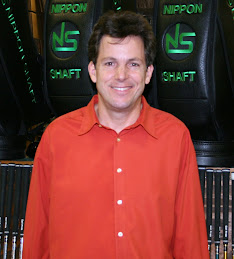
QUESTION: Hello,
Is there any data or published articles comparing the dispersion patterns from a
one number ( flat ) frequency set of irons, and set of golf clubs compared to a
sloped curve ( each club has a higher frequency number ) frequency set? I have
had people claim to me that a steep slope curve is better than a shallow slope
compared to a horizontal or flat curve, and depending upon who is trying to sell
me clubs claiming that this ne is better because of blah, blah, blah. It makes
sense to me that there would be an "Iron Byron" based study to actually quote
data from and settle the argument. I am biased because I have been playing a
one # frequency set for the past 4 sets of clubs, but would actually like to see
some hard published scientific study type data to support one method or another.
Thanks, OFG,
ANSWER: Hi OFG,
The answer to your question is quite easy- “It depends on the golfer”.
Different installation methods with regards to butt frequency slope variations will meet with varying levels of success based on the golfers swing, how they feel the club when they swing, and their past experience.
(For background information to other readers of this Q&A- most every iron set is built to a certain flex, such as REGULAR or STIFF, but each club in the set will measure on a shaft butt frequency meter, progressively stiffer. as you move from the #3 iron to the PW. However, there are some iron sets that are offered by clubmaking shops, that will measure on a shaft butt frequency meter to be the same raw stiffness. If these meter numbers are plotted on a graph, the traditional set will have a line that is moving upward, or a “steep slope”, and the same raw stiffness set will thus have a line that is the same, or a “flat slope”.)
Moving back to our discussion -in simplest terms, most golfers swing with different amounts of “strain” on the shaft for different clubs. This is partly because they have learned to swing based on a steeper frequency type slope. This is also because this is what they have found feels best to them. Other golfers, typically who have the same length backswing, and exert the same amount of force or strain on the shaft, from their long irons to their short irons, prefer a flatter, single frequency type slope.
Neither system is right or wrong. Adjusting the slope, or relative shaft butt stiffness from club to club, is actually a fitting tool than can be used to match an overall shaft flex scheme to the type of golfer.
The discussion is also a “chicken or the egg” type argument. It can be argued that most golfers should play with a traditional steep slope because their swings dictate this. It can also be argued that most every golfer uses a steep slope set only because that is the system that their swings learned on and thus are based on. Maybe if everyone learned how to swing and play with a flat-line slope, when they first played the game, the steep slope users would be in the minority.
Doing an “Iron Byron” test would not yield any good data as to the preferred method since a robot type device would only be measuring which slope type would be best for the type of swing that you chose for the robot.
My best recommendation is to play with both type of sets, and make your conclusion based on the following statement- “Which set allowed you to swing in the most efficient, natural, and comfortable manner, without the need to adjust or manipulate your swing?”.
Regards, Mark







